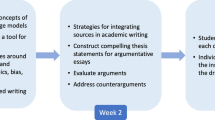Mercer, N. (1995) coined the term interthinking to link the cognitive and social functions of group talk. Essentially, interthinking means using talk to think collectively, to engage with others’ ideas through oral language. In this article I share four excerpts from small group interactive read-aloud sessions that were conducted with Grade 1 children, and examine the nature of the interthinking that occurred during these discussions of picture books with Radical Change characteristics (Dresang, E. 1999). I examine the types of discourse that occurred during these read-aloud sessions and some of the techniques I used to guide the children in their construction of knowledge of these contemporary picture books.
Similar content being viewed by others
References
Allington R. (2002) What I’ve learned about effective reading instruction from a decade of studying exemplary elementary classroom teachers. Phi Delta Kappan, 83(10), 740–747
Barnes D. (1976). From communication to curriculum (1st ed.). Harmondsworth: Penguin
Barnes D. (1992). From communication to curriculum (2nd ed.). Portsmouth, NH: Boynton/Cook Publishers.
Barrentine S. J. (1996). Engaging with reading through interactive read-alouds. The Reading Teacher, 50(1), 36–43
Berk L., & Winsler A. (1995). Scaffolding children’s learning: Vygotsky and early childhood education. National Association for the Education of Young Children, Washington, DC
Britton J. (1968). Response to literature. In: Squire J. R. (Eds) Response to literature: The Dartmouth seminar papers. National Council of Teachers of English, Champaign, IL pp. 3–10
Cazden C. (1998). Classroom discourse: The language of teaching and learning. Portsmouth, HH: Heinemann.
Clay M. (1998). By different paths to common outcomes. York, ME: Stenhouse Publishers.
Copenhaver J. (2001). Running out of time: Rushed read-alouds in a primary classroom. Language Arts, 79(2):148–158
Dawes L. (2001). Talking about language. In: Goodwin P. (Eds) The articulate classroom: Talking and learning in the primary classroom. David Fulton, London pp. 125–132
Dewey J. (1966). Democracy and education. First Press, New York
Doonan J. (1999). Drawing out ideas: A second decade of the work of Anthony Browne. The Lion and the Unicorn, 23(1):30–56
Dresang E. (1999). Radical change: Books for youth in a digital age. The H. W. Wilson Company, New York
Gallas K. (1995). Talking their way into science. Teachers College Press, New York
Halliday M. (1969). Relevant models of language. Educational Review, 21(3):26–37
Iser W. (1978). The act of reading. Johns Hopkins University Press, Baltimore, MD
Klein M. (1977). Talk in the language arts classroom. National Council of Teachers of English, Urbana, IL
Lindfors J. (1987). Children’s language and learning (2nd ed.). Allyn and Bacon, Boston, MA
Lindfors J. (1999). Children’s inquiry: Using language to make sense of the world. Teachers’ College Press, New York
McRobbie C., Tobin K. (1997). A social constructivist perspective on learning environments. International Journal of Science Education, 19(2):193–208
Mercer N. (1995). The guided construction of knowledge: Talk amongst teachers and learners. Multilingual Matters Ltd, Clevedon, UK
Mercer N. (2000). Words and minds: How we use language to think together. Routledge, London
Mercer N., Fernandez M., Dawes L., Wegerif R., Sams C. (2003). Talk about texts at the computer: Using ICT to develop children’s oral and literate abilities. Reading: Literacy and Language, 37(2):81–89
Pantaleo S. (2003). The art of playful parody: Exploring David Wiesner’s Tuesday. The Dragon Lode, 22(1):42–50
Pantaleo S. (2004). Young children and radical change characteristics in picture books. The Reading Teacher, 58(2):178–187
Pantaleo, S. (2005). ‘Reading’ young children’s visual texts. Early Childhood Research & Practice [On-line serial] 7 (1). Available http://ecrp.uiuc.edu/v7n1/pantaleo.html
Pinnell, G., & Jaggar, A. (2003). Oral language: Speaking and listening in elementary classrooms. In J. Flood, D. Lapp, J. Squire, & J. Jensen (Eds.), Handbook of research on teaching the English language arts (2nd ed.) (pp. 881–913). Mahwah, NJ: Lawrence Erlbaum Associates Publishers
Rosenblatt L. (1981). The readers’ contribution in the literary experience. The English Quarterly, 14(1):3–12
Ryan M., Anstey M. (2003). Identity and text: Develo** self-conscious readers. Australian Journal of Language and Literacy, 26(1):9–22
Schwandt T. (1998). Constructivist, interpretivist approaches to human inquiry. In: Denzin N., Lincoln Y. (Eds) The landscape of qualitative research: Theories and issues. Sage Publications, Thousand Oaks, CA pp. 221–259
Sipe L. (2000). The construction of literary understanding by first and second graders in oral response to picture storybook read-alouds. Reading Research Quarterly, 35(2):252–275
Taylor B., Peterson D., Pearson P. D., Rodriguez M. (2002). Looking inside classrooms: Reflecting on the “how” as well as the “what” in effective reading instruction. The Reading Teacher, 56(3):270–279
Torr J. (2004). Talking about picture books: The influence of maternal education on four-year-old children’s talk with mothers and pre-school teachers. Journal of Early Childhood Literacy, 4(2):181–210
Vygotsky L. (1978). Mind in society. Harvard University Press, Cambridge, MA
Wasik B., Bond M. (2001). Beyond the pages of a book: Interactive book reading and language development in preschool classrooms. Journal of Educational Psychology, 93(2):243–250
Children’s Literature References
Browne A. (1997). Willy the dreamer. Candlewick Press, Cambridge, MA
Browne A. (1998). Voices in the park. Picture Corgi Books, London
Gilman P. (1992). Something from nothing. Scholastic Canada, Ltd, Richmond Hill, ON
Lyon G. (1996). A day at damp camp. Orchard Books, New York
Macaulay D. (1995). Shortcut. Houghton Mifflin, Boston, MA
Scieszka J. (1989). The true story of the three little pigs. Scholastic Inc, New York
Wiesner D. (1991). Tuesday. Clarion Books, New York
Wiesner D. (2001). The three pigs. Clarion Books, New York
Acknowledgement
This study was supported by an Elva Knight Grant from the International Reading Association.
Author information
Authors and Affiliations
Corresponding author
Rights and permissions
About this article
Cite this article
Pantaleo, S. Interthinking: Young Children Using Language to Think Collectively During Interactive Read-alouds. Early Childhood Educ J 34, 439–447 (2007). https://doi.org/10.1007/s10643-007-0154-y
Received:
Accepted:
Published:
Issue Date:
DOI: https://doi.org/10.1007/s10643-007-0154-y




